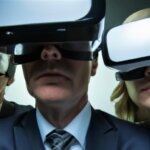Brick-and-mortar stores stock up on retail operations software

|
Getting your Trinity Audio player ready...
|
Main street retailers, high street shops, local traders, and out-of-town malls – wherever you look, brick-and-mortar stores face competition from businesses serving customers online. Plus, internet shopping experiences get better every day as online firms use clicks and page views to improve their digital storefronts. And those e-commerce sites are only a swipe away if you have a smartphone, which a huge number of shoppers do.
Technology can help in physical retail environments too. Touch screens are becoming more commonplace in brick-and-mortar stores – for example, with the rise of self-serve kiosks. And on TechHQ, we’ve written about how self-powered Bluetooth product labels improve supply chain visibility and enable real-time carbon-emissions tracking.
But asking brick-and-mortar stores to pay for extra technology when sales are down and budgets are tight, isn’t likely to go down well. Also, online stores may have cyber-attacks to contend with, but they are much more resilient against a growing problem for retailers – shoplifting.
Politely known as ‘shrinkage’ in the retail industry, brick-and-mortar stores are reporting high losses from theft. There are multiple triggers for the rise in the amount of goods being stolen from physical stores – inflation and higher food prices are a couple of the concerns being voiced. And owners of brick-and-mortar stores are certainly not alone in wanting to hear some good news.
Retail analytics for brick-and-mortar stores
Fortunately, online stores don’t have a monopoly on being able to profit from retail data, and taking a methodical look at what’s in real-world shopping baskets turns out to be incredibly enlightening. Retail analytics can shine a light on who’s visiting different locations and when.
For example, it’s possible to create customer personas based on the contents of a shopping basket and back-calculate whether stores should be catering to professionals, families, or both. “By understanding how customers shop, we can advise grocers on what to display,” Sam Vise – CEO of Optimum Retailing – told TechHQ.
Vise got into the retail analytics business helping technology firms such as Sky navigate the move into physical stores, advising clients on how big the sales area should be and what fixtures to include and where. To do that, he and his team had to upload detailed floor plans, and the process was a springboard to offering what the North American firm dubs an in-store experience management solution.
VR opportunities on the agenda.
According to Optimum Retailing, the analytics tool – which connects with a variety of third-party platforms such as Oracle, SAP, Hubspot, and Salesforce services – can increase topline revenue for brick-and-mortar brands by double digits within 12-18 months.
The approach makes use of planograms, which help retailers optimize their fixture space by highlighting what goods should go where on the shelves. But there’s more that can be presented in the format than just documenting product locations. “We know where products are in the store, and look at every purchase that takes place,” said Vise.
Linking planograms with shopping basket data gathered at the checkout, quickly shows how those fixtures and product layouts are performing. Vise describes the results as a heat map that makes it easy to see which items are underselling (in other words, locking up shelf space) and overselling – a missed sales opportunity and a negative experience for shoppers.
Returning to the persona examples of professionals shopping Mondays to Fridays and families stocking up at the weekend, brick-and-mortar stores can make sure that they display larger pack sizes on Saturdays and Sundays. Smart planograms convey all this information to retailers, helping them maximize the performance of shelf space.
Firms such as Optimum Retailing can help brick-and-mortar stores improve their operations in a number of ways. As mentioned, the first is by guiding retailers on what to put where and in the right quantity – instructions that adapt to match different shopping behavior at different times.
The technology can also be used to manage shelf life, by only bringing perishable items out of bulk cold storage when the data shows that goods have the strongest sales window. Food waste is a big problem and having systems that help grocery stores utilize products at the optimum time can help curb those losses, bringing financial and environmental savings.
In some cases, the numbers may even show that it’s possible for operators to profit from a store that’s 50% smaller, with a reduced footprint lowering energy consumption and enabling retailers to be more efficient.
Planograms can indicate inventory that’s particularly vulnerable to shrinkage and gives store owners the opportunity to relocate items to locations that are easier to monitor or protect. Generative AI makes it easy for clients to quiz their data using natural language prompts rather than needing the knowledge of a data scientist to query the various features to draw out trends.
Looking ahead, Vise sees stores becoming much more customized to their locations, better representing the needs of local shoppers. “The level of personalization will increase,” he comments.
READ NEXT

Smart tech for the 15-minute city
Brick-and-mortar premises have the opportunity to bring online shoppers in-store. Click-and-collect schemes are proving attractive for workers who have returned to the office and are no longer at home to receive their online orders.
And once shoppers walk through the door, who knows what extra items they will buy. “30% of a store’s revenue can be from products that customers weren’t there to shop for,” said Vise.
A long snaking path towards the cash desk can be a gold mine for brick-and-mortar stores with the right products on display. And in-store experience management solutions can help retailers with that.
Smart city tech
Lastly, it’s worth touching on the rise of smart city tech and the insights that it can bring to firms. As well as having in-store information, retailers can tap into a variety of other data feeds such as local weather and footfall – to give just a couple of examples. The urban observatory developed by Newcastle University in the UK shows how smart city technology could feed into the retail environment.
The challenge for brick-and-mortar stores on how to compete with e-commerce is a significant one. But just as online retailers have thrived by using data, it’s possible for physical stores to use digital tools to up their game. And this includes virtual reality headsets.
Speaking with TechHQ, Vise is upbeat about developments in VR technology. “We can do A-B testing,” he comments – noting the possibilities of recreating layouts in VR and then observing how shoppers navigate different retail environments and product fixture designs.
Surviving the age of internet shopping has been tough for brick-and-mortar stores. But hopefully, the coming digital future will be better for physical retail and bring people back to city shops.








